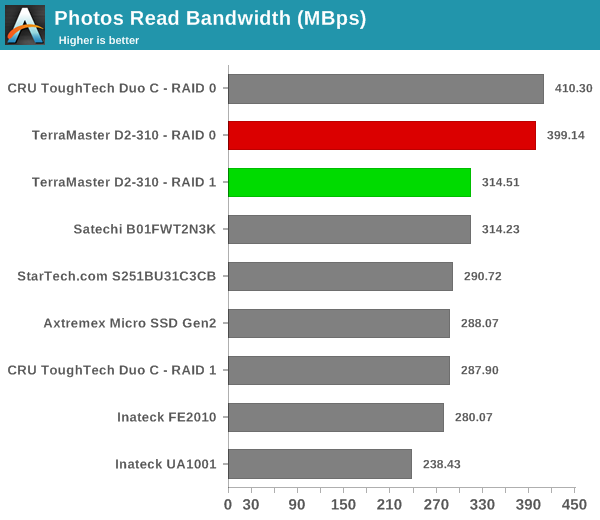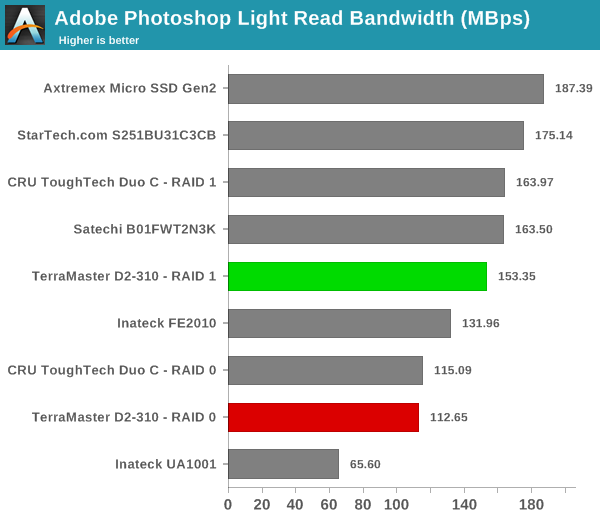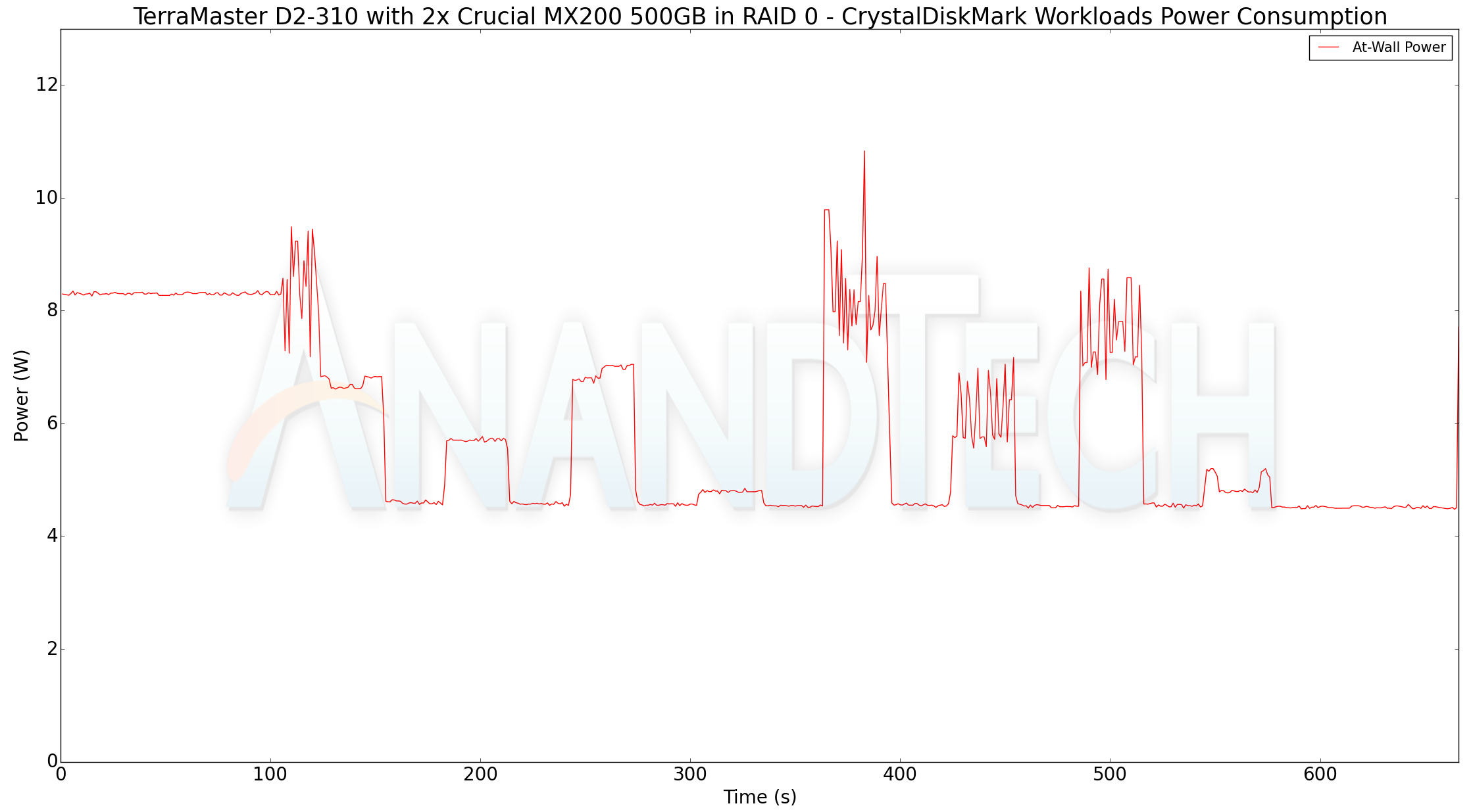TerraMaster D2-310 Storage Enclosure (2x 2.5"/3.5" SATA to USB 3.1 Gen 2 Type C) Mini-Review
by Ganesh T S on July 5, 2017 8:45 AM EST- Posted in
- Gadgets
- DAS
- USB 3.1
- Type-C
- TerraMaster
Performance with SSDs
Storage bridges operate in the maximum possible performance mode when the storage media is able to saturate the SATA links. SSDs are best suited for this purpose. Our first set of tests help in understanding how the TerraMaster D2-310 behaves with Crucial MX200 500GB SSDs in the drive bays.
CrystalDiskMark uses four different access traces for reads and writes over a configurable region size. Two of the traces are sequential accesses, while two are 4K rando accesses. Internally, CrystalDiskMark uses the Microsoft DiskSpd storage testing tool. The 'Seq Q32T1' sequential traces use 128K block size with a queue depth of 32 from a single thread, while the '4K Q32T1' ones do random 4K accesses with the same queue and thread configurations. The plain 'Seq' traces use a 1MiB block size. The plain '4K' ones are similar to the '4K Q32T1' except that only a single queue and single thread are used.
Comparing the '4K Q32T1' and '4K' numbers can quickly tell us whether the storage device supports NCQ (native command queuing) / UASP (USB-attached SCSI protocol). If the numbers for the two access traces are in the same ballpark, NCQ / UASP is not supported. This assumes that the host port / drivers on the PC support UASP. We can see that the TerraMaster D2-310 supports UASP. The bridge is also able to sustain as much as 685 MBps for certain workloads.
| Storage Bridge Benchmarks - CrystalDiskMark | ||
 |
 |
|
Moving on to the real-world benchmarks, we first look at the results from our custom robocopy test. In this test, we transfer three folders with the following characteristics.
- Photos: 15.6 GB collection of 4320 photos (RAW as well as JPEGs) in 61 sub-folders
- Videos: 16.1 GB collection of 244 videos (MP4 as well as MOVs) in 6 sub-folders
- BR: 10.7 GB Blu-ray folder structure of the IDT Benchmark Blu-ray (the same that we use in our robocopy tests for NAS systems)
The test starts off with the Photos folder in a RAM drive in the testbed. robocopy is used with default arguments to mirror it onto the storage drive under test. The content on the RAM drive is then deleted. robocopy is again used to transfer the content, but, from the storage drive under test to the RAM drive. The first segment gives the write speed, while the second one gives the read speed for the storage device. The segments end with the purge of the contents from the storage device. This process is repeated thrice and the average of all the runs is recorded as the performance number. The same procedure is adopted for the Videos and the BR folders. Readers interested in looking at all the graphs in one shot can choose the 'Expand All' option in the dropdown menu.

High-performance external storage devices can also be used for editing multimedia files directly off the unit. They can also be used as OS-to-go boot drives. Evaluation of this aspect is done using PCMark 8's storage bench. The storage workload involves games as well as multimedia editing applications. The command line version allows us to cherry-pick storage traces to run on a target drive. We chose the following traces.
- Adobe Photoshop (Light)
- Adobe Photoshop (Heavy)
- Adobe After Effects
- Adobe Illustrator
Usually, PC Mark 8 reports time to complete the trace, but the detailed log report has the read and write bandwidth figures which we present in our performance tables. Note that the bandwidth number reported in the results don't involve idle time compression. Results might appear low, but that is part of the workload characteristic. Note that the same CPU is being used for all configurations. Therefore, comparing the numbers for each trace should be possible across different DAS units. Readers interested in looking at all the graphs in one shot can choose the 'Expand All' option in the dropdown menu.

Thermal Aspects and Power Consumption
The thermal design of external storage enclosures has now come into focus, as high-speed SSDs and interfaces such as USB 3.1 Gen 2 can easily drive up temperatures. This aspect is an important one, as the last thing that users want to see when copying over, say, 100 GB of data to the drive inside the enclosure, is the transfer rate going to USB 2.0 speeds. In order to identify the effectiveness with which the enclosure can take away heat from the internal drive, we instrumented our robocopy DAS benchmark suite to record various parameters while the robocopy process took place in the background. Internal temperatures can only be gathered for enclosures that support S.M.A.R.T passthrough. Readers can click on the graphs below to view the full-sized version. Thanks to the active cooling in the chassis, there are no thermal or performance consistency issues.
| Storage Enclosure Thermal Characteristics | ||
 |
 |
|
The power consumption at the wall was tracked while the CrystalDiskMark workloads were processed. The workloads were set up with an interval time of 30s. The numbers are graphed below for both RAID cases. The peak was around 10.5 W, while the unit with two SSDs idled around 4.3 W.
| Power Consumption - CrystalDiskMark Workloads | ||
 |
 |
|










32 Comments
View All Comments
jabber - Wednesday, July 5, 2017 - link
Timely! Been looking at getting one of these for a simple but speedy data dump.Gothmoth - Wednesday, July 5, 2017 - link
i have it for a few month now and it´s great fro teh price.thought there is one issue.
they go to sleep to fast (after ~10 minutes).
there is a FW update now that they never go to sleep.. not perfect either.
but mine is only on when i backup to the two 6GB drives i put in... so no problem for me.
damianrobertjones - Wednesday, July 5, 2017 - link
Typing on a phone can be tough.Gothmoth - Wednesday, July 5, 2017 - link
well i speak 5 languages more or less, du vollidiot. how many did you learn in your public school....?wrkingclass_hero - Wednesday, July 5, 2017 - link
1/2, we were busy learning about how we kicked Germany's ass twice.stanleyipkiss - Wednesday, July 5, 2017 - link
i suspect that was mostly thanks to the russians.jabber - Wednesday, July 5, 2017 - link
Yeah I hear quite a few other countries were involved but as usual some were later to the party than others...Samus - Wednesday, July 5, 2017 - link
Wow. This certainly took a left turn.HomeworldFound - Wednesday, July 5, 2017 - link
Don't forget the wall... the wall helped too.Hurr Durr - Saturday, July 8, 2017 - link
Your inability to embrace your own security will end you one glorious day.